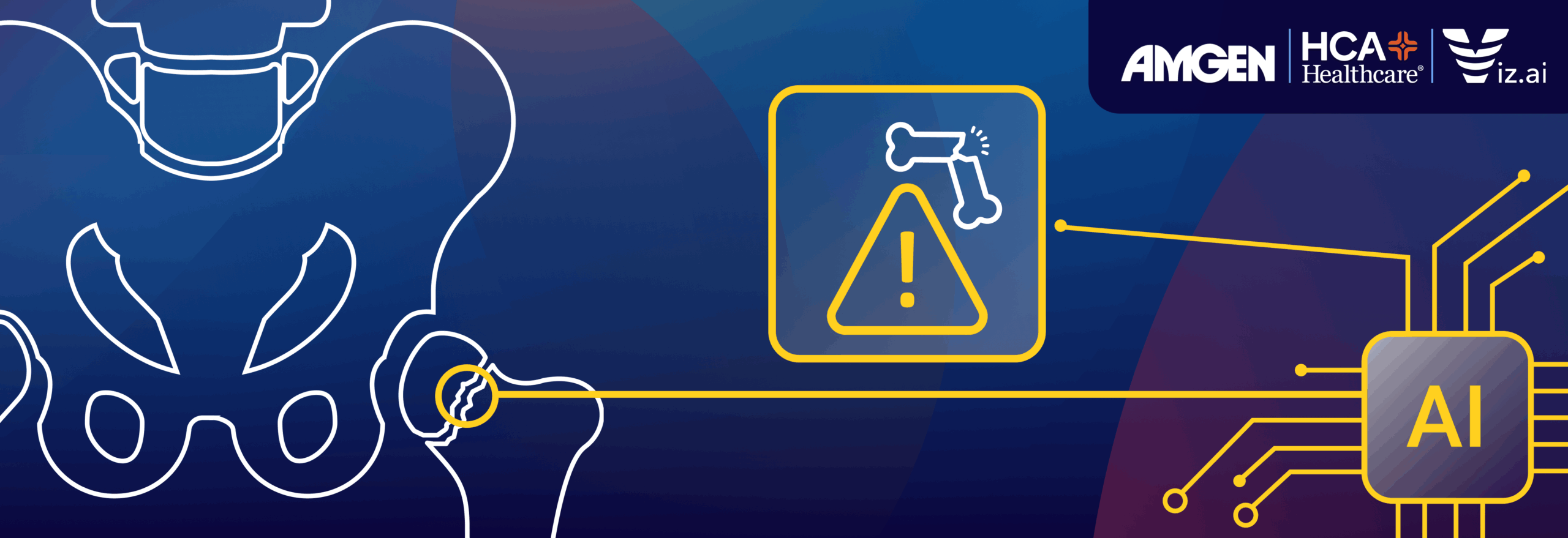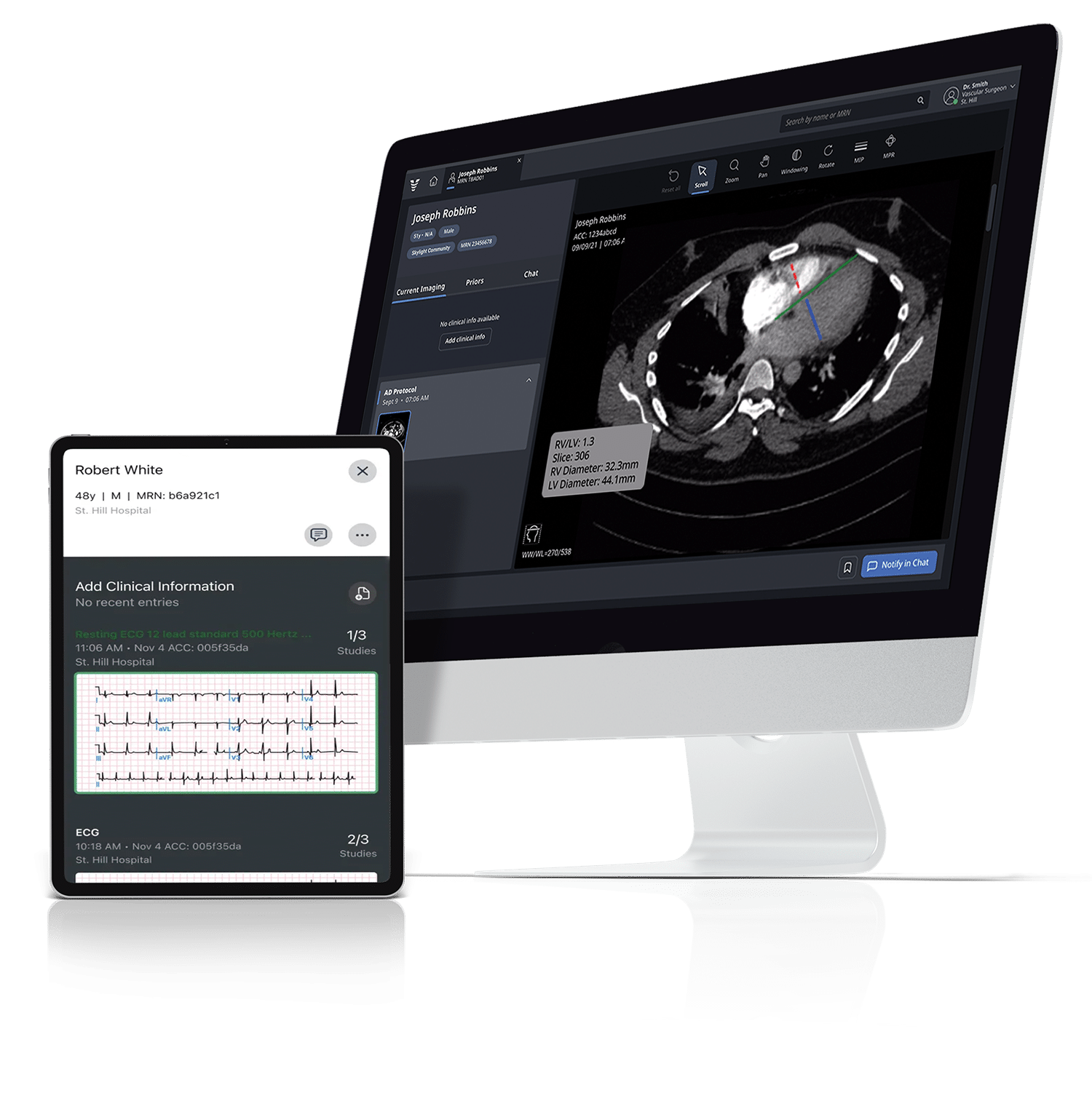Team Viz
Oct 16, 2025
In a new research study sponsored by Amgen, Viz.ai and HCA Healthcare Research Institute will explore the use of AI-enabled tech in osteoporosis care
By Andrea Fox, DMSc, MHA, PA-C, Orthopedic Care Pathway Director, Viz.ai

Despite its scale, osteoporosis often goes undetected.4 For many, their first clinical sign may be a fracture that takes them to an acute care setting, such as the emergency department. In these settings, clinicians often focus on taking care of the acute fracture and may not identify osteoporosis as the underlying cause.5 Fewer than 20% of postmenopausal women receive a diagnosis one year after a fracture.6
This diagnostic gap is more than a missed opportunity—it’s a women’s health crisis. At Viz.ai, we’re committed to advancing women’s health by working to help increase early detection and access to guideline-driven care. That’s why Viz.ai is participating in an Amgen-sponsored research study with the HCA Healthcare Research Institute to explore the impact of Viz Osteoporosis, a digital health solution aimed at surfacing patients who present to the emergency department with a fragility fracture for possible osteoporosis work-up and management. This collaborative project will be conducted leveraging Amgen’s expertise in osteoporosis, led by clinical investigators at qualified HCA hospital sites that utilize Viz’s technology.
“At Amgen, we are committed to addressing the often-overlooked burden of osteoporosis, particularly among women,” said Leandro Boer, MD, PhD, VP, US Medical, General Medicines, Amgen. “Too many patients only discover they have this serious condition after experiencing a fracture. Through this collaboration, we aim to change that trajectory—harnessing technology to support earlier diagnosis and timely guideline-based care. Our hope is that this initiative will not only help reduce the risk of future fractures but also improve long-term outcomes for patients living with osteoporosis.”
Study Overview
This real-world study will explore whether Viz Osteoporosis—a clinical decision support system (CDSS)—can help enable earlier osteoporosis diagnosis, expedite fracture risk reduction strategies, and improve patient care. The study will compare diagnosis, testing, and treatment measures in postmenopausal women or women aged 55+ before and after the tool’s implementation across multiple hospital sites.
The goal is to increase the likelihood that a patient presenting at a hospital or clinic with an acute fragility fracture will receive appropriate follow-up care for a possible underlying osteoporosis diagnosis.
“Published studies involving patients across the country demonstrate that post-acute care for fragility fractures is often fragmented and contributes to high rates of subsequent fractures and missed opportunities for secondary prevention. By joining forces with Viz.ai and Amgen, we’re embedding smarter tools at the point of care to help ensure patients are leaving the hospital, not only with their injuries treated, but set on a path to long-term bone health,” said George A. Helmrich, MD, MBA, CCD, FACOG, Principal Investigator & Chief Medical Officer of Grand Strand Health.
Viz Osteoporosis Patient Journey
When a postmenopausal patient arrives at the emergency department with symptoms consistent with a hip or vertebral compression fracture, the Viz.ai decision-support AI Agent (“Viz Osteoporosis”) will activate in real time. It will review information in the electronic health record (EHR)—including medical history, risk factors, laboratory and imaging reports, and details of past procedures and therapies—to assess risk of osteoporosis.
Viz Osteoporosis is designed to be an intelligent software system that autonomously analyzes the EHR’s clinical data, applies established care guidelines, and prompts clinicians to take timely, evidence-based action—helping bridge the gap between risk identification and follow-up care.
A large language model then compares the clinical picture with guidelines from the American Association of Clinical Endocrinology (AACE) and National Osteoporosis Foundation. If the AI Agent identifies a potential correlation between the patient’s data and the guidelines, it will alert their clinician to possible underlying osteoporosis.
If the suspected diagnosis is confirmed by the HCP, the AI Agent is designed to prompt the clinician to include the appropriate ICD codes in the patient’s chart and recommend guideline-driven next steps. These may include ordering a bone mineral density (BMD) assessment if one hasn’t been performed, or referring the patient to a metabolic bone clinic. Viz.ai’s care coordination tools are designed to support these next steps by facilitating tailored discharge planning and referrals as needed.
Why This Matters
Osteoporosis is a silent disease—often missed, frequently undertreated, and most likely to affect women, especially those in diverse or underserved communities. As populations age, that number is expected to grow. We are excited to work with Amgen and the HCA Healthcare Research Institute on this important research study with the goal of improving healthcare delivery for high-risk osteoporosis patients.
This initiative is part of Viz.ai’s broader commitment to transforming women’s health and addressing underdiagnosis in historically overlooked populations—from osteoporosis to heart disease. Together, we can help ensure that fewer women fall through the cracks.
Bio: Andrea Fox, DMSc, MHA, PA-C, is the Orthopedic Care Pathway Director at Viz.ai, where she is spearheading innovative clinical pathways to improve osteoporosis diagnosis, referrals, and treatment for patients after low energy fractures. As a nationally recognized expert in bone health, she aims to scale best practice solutions through AI technology and large language models across systems nationwide.
References
- Keen MU, Barnett MJ, Anastasopoulou C. Osteoporosis in Females. [Updated 2025 Jun 29]. In: StatPearls [Internet]. Treasure Island (FL): StatPearls Publishing; 2025 Jan-. Available from: https://www.ncbi.nlm.nih.gov/books/NBK559156/
- Sözen T, Özışık L, Başaran NÇ. An overview and management of osteoporosis. Eur J Rheumatol. 2017;4(1):46-56. doi:10.5152/eurjrheum.2016.048
- Bone Health and Osteoporosis Foundation. What is osteoporosis and what causes it? Bone Health & Osteoporosis Foundation. Accessed April 21, 2025. https://www.bonehealthandosteoporosis.org/patients/what-is-osteoporosis
- Onizuka N, Onizuka T. Disparities in osteoporosis prevention and care: understanding gender, racial, and ethnic dynamics. J Osteoporos Bone Res. 2024. Accessed April 21, 2025. https://www.ncbi.nlm.nih.gov/pmc/articles/PMC11335991/
- Everhart A, Brito J, Clark B, et al. Trends in osteoporosis drug therapy receipt among commercial and Medicare Advantage enrollees in the United States, 2011-2022. J Clin Endocrinol Metab. 2025;00(0):1-10. doi:10.1210/clinem/dgae840
- Data on file, Amgen; 2024. IQVIA patient claims data (women ≥50 years, 2019–2023).
